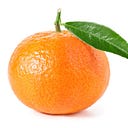Ruby Programming Exercises #1: Printing out Shapes
Excerpt from my book Learn Ruby Programming by Examples
This article is an adapted version of the exercises in the first chapter of the book: Learn Ruby Programming By Examples.
Printing out asterisk characters (*) in shapes is often used as beginner’s programming exercises, as they are simple, easy to understand, and visually interesting.
You can install Ruby, edit in your favourite editor and run from the command line. Or, try online Ruby sites, where you can write and run code in your browser.
Table of Contents:
· Ex 1: Print a Triangle
· Ex 2: Print a Half-Diamond
· Ex 3: Print a Diamond
· Challenges
· Solutions
∘ Ex 1: Print a Triangle
∘ Ex 2: Print a Half Diamond
∘ Ex 3: Print a DiamondEx 1: Print a Triangle
Write a program to print out asterisks in the triangle shape below:
*
**
***
****
*****The naive solution is to print each line manually. In Ruby, you can print a newline with puts.
puts '*'
puts '**'
...But we can do better!
Noticing that row 1 has 1 asterisk, row 2 has 2 asterisks, row 3 has 3 asterisks, etc. We can use this pattern to create triangles of any size.
Here are some tips to help along the way:
Tip 1: Printing the same character multiple times
To generate multiple occurrences of the same character, use the multiply symbol *. e.g. 'X' * 3 will output XXX.
Tip 2: Defining a variable
In Ruby, defining variables is as easy as:
star_count = 2
puts '*' * star_count # => **star_count = star_count + 2 # now star_count = 3
puts '*' * star_count # => ***
Tip 3: Loop a fixed number of times
3.times do
puts "Hello!"
endThe above segment loops over the contents between do … end 3 times. i.e. the output will be:
Hello!
Hello!
Hello!Now, have a go at printing the triangle yourself before scrolling down to see the solutions :)
Ex 2: Print a Half-Diamond
In the first exercise, we printed a triangle. Now, let’s extend that further into a half-diamond shape:
*
**
***
****
*****
****
***
**
*Now we aren’t always incrementing star_count; from the middle row we need to start decrementing it.
Tip 4: Control flows using if … else
We can add control flow using if …else to run different code statements.
For instance, let’s take simple grades program:
score = 75
if score >= 60 # greater than or equal to 60
puts "Passed!"
else # when score is less than 60
puts "Failed"
endThe output of this program is Passed!.
Now have a go extending “Print a Triangle” to “Print a Half-Diamond”, my solution will be at the bottom of this article.
Ex 3: Print a Diamond
This is an extension to Ex02: to print 7 rows of a full diamond instead of a half.
*
***
*****
*******
*****
***
*This time, you will need to consider both the number of spaces and the number of stars. The tricky part is finding the pattern. However, if you can complete the previous two parts, then you know everything you need to print a diamond.
Challenges
Challenge yourself by printing different shapes like the below ones.
Rhombus
*****
*****
*****
*****
*****Hollow Square
*****
* *
* *
* *
*****Heart
***** *****
******* *******
********* *********
*******************
*****************
***************
*************
***********
*********
*******
*****
***
*Solutions
Ex 1: Print a Triangle
count = 0
10.times do
count = count + 1
stars = "*" * count
puts stars
endEx 2: Print a Half Diamond
There are two alternative approaches to this problem.
- Reuse the solution to Part 1 twice, but
countdecreases in the second loop.
count = 0
8.times do
count = count + 1
stars = "*" * count
puts stars
endcount = 10
8.times do
count = count - 1
stars = "*" * count
puts stars
end
2. Use control flow with if
15.times do |row|
# row starting with 0
if row < 8
star_count = row + 1
else
star_count = (15 - row)
end
puts '*' * star_count
endEx 3: Print a Diamond
15.times do |row|
if row < 8
star_count = row * 2 + 1
space_count = 8 - row
else
star_count = (15 - row) * 2 - 1
space_count = row - 6
end
puts ' ' * space_count + '*' * star_count
endFor solutions to the challenges, check out the book’s solutions section.
